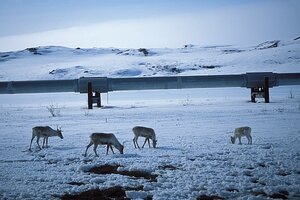Alaska oil pipeline has safety and environmental risks
The US Department of Transportation’s pipeline safety division says the 800-mile trans-Alaska pipeline is corroded and poses a severe public safety and environmental risk.

Caribou along the Trans-Alaska pipeline in the Arctic, North Slope, Alaska. Federal regulators say the 800-mile pipeline is corroded and poses a severe public safety and environmental risk.
Newscom
Chicago
The US Department of Transportation’s pipeline safety division says the trans-Alaska pipeline is corroded and poses a severe public safety and environmental risk.
The 800-mile pipeline ships 12 percent of the domestic oil supply. In a letter sent earlier this month to the Alyeska Pipeline Service Co., a coalition of oil companies that control the pipe, the Pipeline and Hazardous Materials Safety Administration [PHMSA] says “multiple conditions … pose a pipeline integrity risk.”
A reason for the increased corrosion is limited use. Oil began flowing through the 48-inch diameter pipeline in 1977. At its peak, the pipeline carried 2.1 million barrels per day, crossing three mountain ranges, from the North Slope of Alaska to Valdez, the state’s northernmost port.
Capacity has dropped starting in the late 1980’s. According to Alyeska Pipeline Service data, between 2000 and 2010, total annual capacity has dropped 38 percent. Today the pipeline operates at less than one-third of the 2.1 million barrels per day that flowed soon after it was built.
The decrease in oil flow is accompanied by a drop in crude oil temperatures, which leads to corrosion. The lower temperatures also create the risk that the water mixed with crude oil may freeze in case the pipeline needs to be temporarily shut down. The PHMSA letter said, “the water itself is another corrosion hazard” which could damage all components of the pipeline including the instrumentation and valves.
Regulators listed 13 corrective measures they say are necessary, including the replacement of any piping that cannot be assessed properly, additional technology used to mitigate corrosion, and a cold restart plan that can be demonstrated to prove its effectiveness.
The order follows a January leak in the pipeline that released about 13,326 gallons of oil at the North Slope pump station.
A larger oil spill would be dire due to a diminished capacity to recover spilled oil in Alaskan waters.
In testimony given Friday to a House Transportation subcommittee hearing dealing with last year’s Gulf oil spill, retired Coast Guard Rear Adm. Thad Allen said the Coast Guard does not have enough working icebreakers to respond to a spill and that North Slope response and recovery infrastructure is likewise inadequate.
“The current condition of the Coast Guard icebreaker fleet should be of great concern to the senior leaders of this nation,” Adm. Allen testified. As incident commander in the Gulf spill, Allen was responsible for coordinating response operations between government and BP, the responsible party.
Alyeska Pipeline Service spokesperson Michelle Egan told the Associated Press Friday that the company believes “the pipeline is safe and … it’s a large, complex system that we manage within the risk.” Ms. Egan added that Alyeska is requesting a meeting with regulators and that “there are several [items in the letter] we disagree on and there are also several items in there that we have already begun.”
BP owns half of Alyeska Pipeline Service. The other half is largely split between ConocoPhillips and ExxonMobil.
